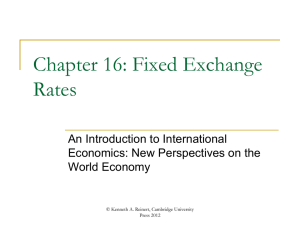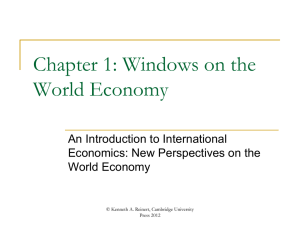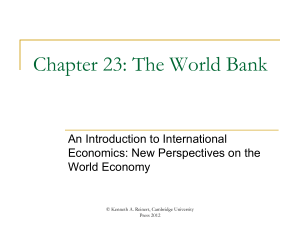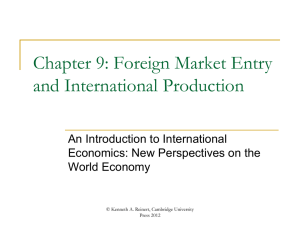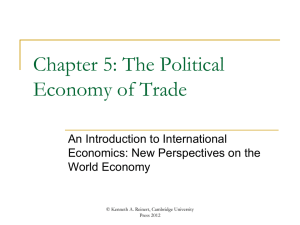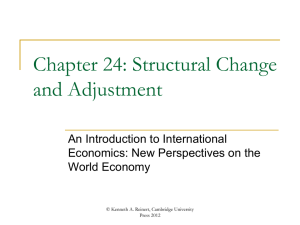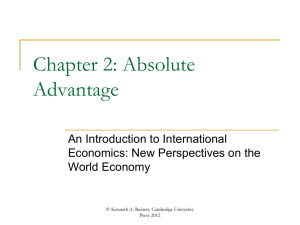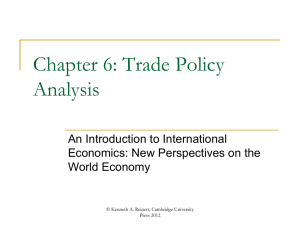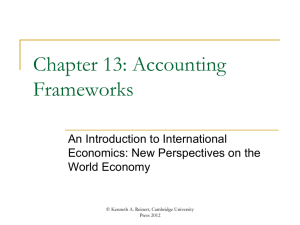Chapter 15 - An Introduction to International Economics
advertisement
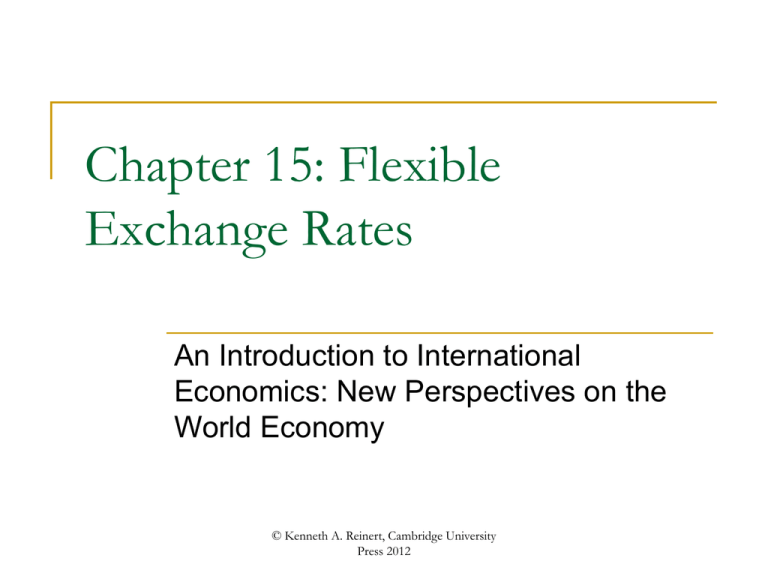
Chapter 15: Flexible Exchange Rates An Introduction to International Economics: New Perspectives on the World Economy © Kenneth A. Reinert, Cambridge University Press 2012 Analytical Elements Countries Currencies Financial assets © Kenneth A. Reinert, Cambridge University Press 2012 Introduction Forces of supply and demand in currency markets determine exchange rate What makes a flexible exchange rate move one way or another? This chapter develops a model of how the nominal exchange rate is determined in currency markets Will first consider a trade-based model Nominal exchange rate is determined by currency transactions arising from imports and exports Will extend model to account for exchange of assets in an assets-based model © Kenneth A. Reinert, Cambridge University Press 2012 Trade-Based Model: Demand for Pesos Begin with one form of the fundamental accounting equations Rewrite this relationship using symbols Foreign Savings = Trade Deficit SF (foreign savings) = Z (imports) - E (exports) or SF = (Z - E) Use Mexico as home country and United States as foreign country SF is foreign savings Savings supplied by US residents who buy Mexican assets SF is a demand for pesos (supply of dollars) by US Assume that demand is invariant with respect to value of peso Gives us the perfectly inelastic demand for pesos curve shown in Figure 15.1 © Kenneth A. Reinert, Cambridge University Press 2012 Figure 15.1: The Demand for Pesos © Kenneth A. Reinert, Cambridge University Press 2012 Trade-Based Model: Supply of Pesos Z - E is the trade deficit Net demand for US goods by Mexico A supply of pesos (demand for dollars) by Mexico Z has a positive relationship to value of peso E has a negative relationship to value of peso Thus Z-E has a positive relationship to value of peso Shown in Figure 15.2 © Kenneth A. Reinert, Cambridge University Press 2012 Figure 15.2: The Supply of Pesos © Kenneth A. Reinert, Cambridge University Press 2012 Table 15.1: Exchange Rate Terminology Case e Value of Peso Term Flexible e ↑ ↓ Depreciation Flexible e ↓ ↑ Appreciation © Kenneth A. Reinert, Cambridge University Press 2012 The Peso Market Combining the demand for pesos and supply of pesos together gives Figure 15.3 We assume that the exchange rate is flexible We consider three alternative exchange rates 1/e1—supply of pesos exceeds demand for pesos Reduces value of peso As the peso depreciates, trade deficit falls Brings the supply and demand of pesos into equality © Kenneth A. Reinert, Cambridge University Press 2012 Figure 15.3: The Peso Market © Kenneth A. Reinert, Cambridge University Press 2012 The Peso Market 1/e2—demand for pesos exceeds supply of pesos 1/e0—demand for pesos equals the supply of pesos Increases value of peso As the peso appreciates, trade deficit rises Brings the supply and demand of pesos into equality Value of peso remains the same Represents equilibrium in the peso market e0 is the equilibrium nominal exchange rate Model is trade-based in the sense that only trade flows respond to a change in value of peso © Kenneth A. Reinert, Cambridge University Press 2012 Capital Inflows and the Peso Market We can use the trade-based model of Figure 15.3 to analyze capital inflows in Figure 15.4 An inflow of capital in the form of foreign savings shifts the SF curve to the right This causes an excess demand for pesos at 1/e0 The value of the peso will begin to increase towards 1/e1 That is, there will be an appreciation of the peso The trade deficit will expand along the (Z - E) graph © Kenneth A. Reinert, Cambridge University Press 2012 Figure 15.4: Capital Inflows and the Peso Market © Kenneth A. Reinert, Cambridge University Press 2012 An Assets-Based Model Views foreign currency transactions as arising from the buying and selling of foreign-currencydenominated assets, rather than from trade flows Pretend you are a Mexican investor, deciding upon the allocation of your wealth portfolio between two assets Focuses on foreign savings rather than on trade deficit in the SF = Z - E relationship A peso-denominated asset A dollar-denominated asset Assume both assets to be open-ended mutual funds with fixed domestic-currency prices You will allocate your portfolio with an eye to rates of return of alternative assets © Kenneth A. Reinert, Cambridge University Press 2012 An Assets-Based Model In the case of peso-denominated assets, return you obtain is the interest rate, or rM Total expected return on the peso-denominated asset is 𝑒 𝑅𝑀 = 𝑟𝑀 Since you are a Mexican investor, dollardenominated assets are a bit more complicated— you must consider The interest rate or 𝑟𝑈𝑆 The exchange rate © Kenneth A. Reinert, Cambridge University Press 2012 An Assets-Based Model Suppose that the initial exchange rate is e1 = 1.0 At this exchange rate, you purchase a dollardenominated asset worth $1,000 and therefore 1,000 pesos Suppose that the peso depreciates so that the new exchange rate is e2= 1.1 The $1,000 asset has increased in value to 1,100 pesos Depreciation of the peso causes a capital gain on the dollar-denominated asset in peso terms © Kenneth A. Reinert, Cambridge University Press 2012 An Assets-Based Model At any point in time, you have your expectation of what exchange rate will be in the future, or ee Your expected rate of depreciation of the peso is ee e e Your expected total rate of return on dollardenominated assets is the sum of the interest rate and the expected rate of depreciation of the peso e RUS rUS e e e e © Kenneth A. Reinert, Cambridge University Press 2012 An Assets-Based Model-Portfolio Allocation Suppose the expected total rate of return on pesodenominated assets exceeds the expected total rate of return on dollar-denominated assets Suppose the expected total rate of return on dollardenominated assets exceeds the expected total rate of return on peso-denominated assets You reallocate your portfolio towards peso-denominated assets, selling dollars and buying pesos You reallocate your portfolio towards dollar-denominated assets, selling pesos and buying dollars Suppose the expected total rate of return on peso- and dollar-denominated assets are the same You keep you portfolio as it is © Kenneth A. Reinert, Cambridge University Press 2012 Interest Rate Parity Condition 𝑒 𝑒 Whenever 𝑅𝑀 and 𝑅𝑈𝑆 are not equal, there will be reason for you to reallocate your portfolio Therefore, equilibrium in the foreign exchange market 𝑒 𝑒 requires that 𝑅𝑀 = 𝑅𝑈𝑆 This gives us the interest rate parity condition rM rUS e e e e Equilibrium in the foreign exchange market requires that the interest rate on peso deposits equals the interest rate on dollar deposits plus the expected rate of peso depreciation © Kenneth A. Reinert, Cambridge University Press 2012 Interest Rate Parity Condition We are going to consider the interest rate parity condition in terms of the peso market in Figure 15.5 𝑒 𝑒 Suppose that 𝑅𝑀 = 𝑅𝑈𝑆 Then the value of the peso increases or e falls For a given expected future exchange rate ee, as e falls, the expected future depreciation increases 𝑒 𝑒 Now 𝑅𝑈𝑆 > 𝑅𝑀 and investors switch into dollar-denominated assets Foreign savings (SF ) or the asset-based demand for pesos declines This gives us the downward-sloping demand curve for pesos in Figure 15.5 © Kenneth A. Reinert, Cambridge University Press 2012 Figure 15.5: An Assets-Based View of the Peso Market © Kenneth A. Reinert, Cambridge University Press 2012 Adjustment in the Peso Market At 1/e1 in Figure 15.5, the supply of pesos exceeds the demand for pesos At 1/e2, the demand for pesos exceeds the supply of pesos The value of the peso falls The trade deficit falls Foreign savings increases as the expected rate of depreciation of the peso falls The value of the peso rises The trade deficit increases Foreign savings deceases as the expected rate of depreciation of the peso rises At 1/e0, the peso market is in equilibrium © Kenneth A. Reinert, Cambridge University Press 2012 Interest Rates and Expectations In the interest rate parity condition, changes in rm and rUS shift the demand for peso graph In Figure 15.6, an increase in rm increases the total expected rate of return on peso-denominated assets An increase in rUS increases the total expected rate of return on dollar-denominated assets The demand curve for pesos shifts to the right and the value of the peso increases The demand curve for pesos shifts to the left and the value of the peso decreases An increase in ee increases the total expected rate of return on dollar-denominated assets The demand curve for pesos shifts to the left and the value of the peso decreases © Kenneth A. Reinert, Cambridge University Press 2012 Figure 15.6: Interest Rates and the Peso Market © Kenneth A. Reinert, Cambridge University Press 2012 Table 15.2: Changes in Currency Markets Change Effect on SF curve Effect on value of home currency (1/e) Term Increase in homecountry interest rate Shifts to right Increases Appreciation Increase in foreigncountry interest rate Shifts to left Decreases Depreciation Increase in expected future home-country exchange rate Shifts to left Decreases Depreciation © Kenneth A. Reinert, Cambridge University Press 2012 Covered vs. Uncovered Interest Rate Parity The interest rate parity condition comes in two varieties, expressed here in terms of home (H) and foreign (F) Uncovered interest rate parity (UIP) Covered interest rate parity (CIP) 𝑟𝐻 = 𝑟𝐹 + 𝑒 𝑒 −𝑒 𝑒 𝑟𝐻 = 𝑟𝐹 + 𝑒 𝑓 −𝑒 𝑒 CIP is considered to hold more or less exactly, since traders make use of forward rates (ef) The empirical question is whether UIP also holds or whether expected rates (ee) are equal to forward rates (ef) © Kenneth A. Reinert, Cambridge University Press 2012 Monetary Policies and the Nominal Rate We can analyze the influence of monetary polices on short term nominal exchange rates using the Keynesian theory of money demand The money demand function is Money demand is positively related to income (Y) 𝑀𝐷 = 𝐿 𝑌, 𝑟 The greater is Y, the greater the transactions demand for money Money demand is negatively related to the interest rate (r) The greater is r, the greater is the opportunity cost of holding money © Kenneth A. Reinert, Cambridge University Press 2012 Monetary Policies and the Nominal Rate We assume that money supply (MS) is set by the central bank or treasury Money demand and money supply are represented in Figure 15.7 An increase in money supply (an expansionary monetary policy) lowers the interest rate as in Figure 15.8 The interest rate falls to increase the demand for money and remove the initial excess supply of money © Kenneth A. Reinert, Cambridge University Press 2012 Figure 15.7: The Money Market © Kenneth A. Reinert, Cambridge University Press 2012 Figure 15.8: An Expansionary Monetary Policy © Kenneth A. Reinert, Cambridge University Press 2012 Money Markets and Exchange Rates In order to analyze the effect of monetary policies on nominal exchange rates, we combine our assets-based diagram (Figure 15.6) with money market diagrams for Mexico and the United States This is done in Figure 15.9 The top diagram depicts the equilibrium in the US money market, which determines the interest rate on the dollar The bottom diagram depicts the equilibrium in the Mexican money market, which determines the interest rate on the peso The middle diagram determines the exchange rate © Kenneth A. Reinert, Cambridge University Press 2012 Figure 15.9: Money Markets and Exchange Rate Determination © Kenneth A. Reinert, Cambridge University Press 2012 Expansionary Monetary Policy in Mexico (Home Country) The case of expansionary monetary policy in Mexico is presented in Figure 15.10 In the Mexican money market diagram, the increase in the money supply causes an excess supply of pesos and a fall of rM The lower rM means that the expected total rate of return on peso-denominated assets is now less than the expected total rate of return on dollar-denominated assets © Kenneth A. Reinert, Cambridge University Press 2012 Expansionary Monetary Policy in Mexico (Home Country) Investors sell pesos and buy dollars, which causes the demand for pesos graph to move to the left As a result of this decrease in the demand for pesos, the value of the peso falls In other words, there is a depreciation of the Mexican peso © Kenneth A. Reinert, Cambridge University Press 2012 Figure 15.10: Expansionary Monetary Policy in Mexico (Home Country) © Kenneth A. Reinert, Cambridge University Press 2012 Expansionary Monetary Policy in the United States (Foreign Country) The case of expansionary monetary policy in the United States is presented in Figure 15.11 In the US money market diagram, the increase in the money supply causes an excess supply of dollares and a fall of rUS The lower rUS means that the expected total rate of return on dollar-denominated assets is now less than the expected total rate of return on peso-denominated assets © Kenneth A. Reinert, Cambridge University Press 2012 Expansionary Monetary Policy in the United States (Foreign Country) Investors sell dollars and buy pesos, which causes the demand for pesos graph to move to the right As a result of this increase in the demand for pesos, the value of the peso rises In other words, there is an appreciation of the Mexican peso © Kenneth A. Reinert, Cambridge University Press 2012 Figure 15.11: Expansionary Monetary Policy in the United States © Kenneth A. Reinert, Cambridge University Press 2012
